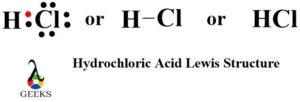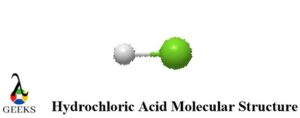Hydrochloric Acid Lewis Structure is very easy to draw as it focuses on stability and completion of the octet rule. In this article, the hydrochloric acid Lewis structure is described.
Hydrochloric acid is made up of two elements i.e. hydrogen and chlorine. Hydrogen consist of 1 electron in its valence shell and chlorine consist of 7 electrons in its valence shell. So to achieve their desired stability which is the nearest noble gas configuration, they will share their 1 electron thereby forming a single covalent bond.
To dive into the detailing of hydrochloric acid Lewis structure, it is really important to be aware of the total number of the valence electron in the molecule. According to the periodic table, hydrogen (Atomic number = 1 and electronic configuration = 1) belongs to the 1st group with 1 valence electron and chlorine (Atomic number = 17 and electronic configuration = 2,8,7) is in the 7th group with 7 valence electrons. This makes the total valence electrons as 1 + 7 = 8.

Determining the central atom is the next important step for drawing the hydrochloric acid Lewis structure. Over here chlorine is the central atom as it is electronegative.
Next check the lone pair of electrons in both the atoms involved and start the sharing process to convert lone pairs to bond pairs. This will lead to a single covalent bond where both hydrogen and chlorine will share each of their electrons to acquire the stability criteria. In hydrochloric acid Lewis structure, there are no lone pairs on hydrogen but there are 3 lone pairs of electrons on chlorine.
To confirm the stability of hydrochloric acid Lewis structure it is important to calculate the formal charge of both the atoms in the molecule. Here the formal charge of hydrogen and chlorine is zero, thereby giving us the most stable and reliable hydrochloric acid Lewis structure.
Role of Hydrochloric acid Lewis Structure in Polarity
Though hydrochloric acid Lewis structure has explained electron count, stability, and formal charge, there is another important aspect of polarity explained by it. Emphasizing the polarity aspect the hydrochloric Lewis structure has chlorine which has greater electronegativity potential than hydrogen. Electronegativity means the electron attracting ability of charged entities.
So chlorine atom in hydrochloric Lewis structure has relativity more negative charge and becomes negative pole. On the flip side, hydrogen will have a more positive charge and will become a positive pole. This will lead to the generation of partial positive charge and partial negative charge on hydrochloric acid Lewis dot structure. Due to the differences in the electronegativities, hydrochloric acid will become a polar covalent molecule with a dipole moment of 1.03 D.
Molecular Structure representation of Hydrochloric acid
The molecular geometry of hydrochloric acid is very important in terms of shape and hybridization. There are two different geometries of the hydrochloric acid molecule. It is usually observed that when lone pairs of chlorine are taken into consideration then hydrochloric acid shows tetrahedral geometry. And when only atoms are considered then hydrochloric acid exhibits linear geometry. Also, it has no hybridization because it is already quite stable and has only one structural representation.

One important fact to pay attention to is that hydrochloric acid is formed from hydrogen chloride gas when dissolved in water. It is also called muriatic acid and is represented as [H+ (aq) Cl– (aq)]. It is a transparent water-like solution with a strong pungent odor. It also releases distinctive visible fumes if not stored properly. Hydrochloric acid is one of the strong acids with a large Ka value (acid dissociation constant).
Applications of Hydrochloric acid
Hydrochloric acid is of great significance as it is found in the gastric juice digestive system of humans and other animal species. It is frequently used in laboratory setup and industrially for commercial purposes. There are many applications related to it due to its strong acidity and corrosive nature.
HCl is used at a large scale in the polymer industry. It is one of the reactants in the synthesis of PVC (Polyvinyl chloride). Polyvinyl chloride is resistant to corrosion by HCl. For this reason, only PVC containers and tanks are used for HCl storage and transportation.
HCl is responsible for regulating pH levels. In the human stomach, it not only maintains the pH level but protects the stomach lining from any kind of contamination from an outside source. It also regulates and maintains pH levels in food items and pharmaceuticals. HCl also triggers the purification process when added to impure sodium chloride thereby providing a safe and edible table salt. It is used for separating rust and other impurities from various alloys. It is also used in leather tanning processes. It controls the development of bacteria and fungus on leather products.
HCl act as ion exchangers which maintain water safety. It removes harmful ionized particles from the water and is used by various mineral water industries for the safe supply of bottled water. In addition to that, it is a major component of wastewater management.
HCl is a major component of the oil and gas extraction process. It acidifies oil and gas wells to remove debris like that of limestone and carbonate reservoirs, quartz, clay, and rocks. It is called the fracking process as it made the extraction easy and pure production of natural substances
In the food production industry, it is used as an accompaniment and helps in various other production processes. It hydrolyses various vegetable proteins, citric acid, and fructose or sugar components.
Hazards of Hydrochloric acid
HCl is a very useful chemical on both a small and large scale. But it is a quite intimidating compound as well and should be used with proper safety measures. If used carelessly then it can harm the skin and eyes and chemists can experience blisters, burns, pain, and vision loss. Accidental ingestion of concentrated HCl can cause poisoning, mouth and throat burn, nausea, chest pain, and rapid shock due to lowering of blood pressure. Immediate first-aid and treatment should be provided to the patient.
Hydrochloric Acid Lewis Structure (Related FAQs)
Comment about the combustibility of HCL.
It is non-combustible in both liquid and gaseous states and is a non-supporter of combustion.
What is the difference between hydrogen chloride gas and hydrochloric acid?
HCl gas-only has molecules and hydrochloric acid has ions H+ and Cl–. The gas does not conduct electricity and does not show any changes to the litmus paper. On the other hand, the acid is a good conductor of electricity and turns blue litmus red.
Also Read:
- Ibr2 lewis structure
- Bacl2 lewis structure
- Xef2o lewis structure
- Pcl3 lewis structure
- Xef5 lewis structure
- Sp lewis structure
- Nh2f lewis structure
- H2so4 lewis structure
- Li lewis structure
- Nai lewis structure

Hello, I am Mansi Sharma, I have completed my master’s in Chemistry. I personally believe that learning is more enthusiastic when learnt with creativity. I am a Subject Matter Expert in Chemistry.
Let’s connect through LinkedIn: https://www.linkedin.com/in/mansi-sharma22